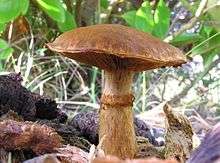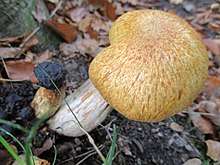Gymnopilus junonius
Gymnopilus junonius is a species of mushroom in the family Cortinariaceae. Commonly known as the Spectacular Rustgill, this large orange mushroom is typically found growing on tree stumps, logs, or tree bases. Some subspecies of this mushroom contain the neurotoxic oligoisoprenoid gymnopilin.
| Gymnopilus junonius | |
|---|---|
 | |
| Scientific classification | |
| Kingdom: | |
| Division: | |
| Class: | |
| Order: | |
| Family: | |
| Genus: | |
| Binomial name | |
| Gymnopilus junonius (Fr.) P.D.Orton (1960) | |
 | |
| Approximate range of Gymnopilus junonius | |
| Synonyms | |
| Gymnopilus junonius | |
|---|---|
float | |
| gills on hymenium | |
| cap is convex | |
| hymenium is adnate | |
| stipe has a ring | |
| spore print is reddish-brown | |
| ecology is saprotrophic | |
| edibility: inedible | |
Taxonomy
This species was formerly known as Gymnopilus spectabilis, or Pholiota spectabilis v. junonia (Fr.) J.E Lange.[1] The 'Gymn' in the present nomen means 'naked', and 'Juno' was the wife of Jupiter.[2]
Description
The cap ranges from 7 to 20 cm across, is convex, and is bright yellow-orange in younger specimens and orange/brown or reddish brown in older ones, with a dry scaly surface. The stem is 2.5 to 26.5 cm long, 1 to 4 cm thick, and often narrows near the base. The frail ring is dusted with rusty orange spores, the flesh is yellow and the gill attachment to the stem is adnate to sub-decurrent. It has a bitter taste, stains red with KOH and turns green when cooked in a pan. The spore print is rusty orange. It never bruises blue, unlike its psychoactive relatives. [3] This mushroom usually grows in clusters from several to several dozen individuals, but sometimes grows solitary.

Similar species
This mushroom is often mistaken for Gymnopilus ventricosus, which also contains no psilocybin. [3]
Distribution and habitat
Gymnopilus junonius is found in Europe, Australasia and South America, but not in North America. It grows in dense clusters on stumps and logs of hardwoods and conifers. This mushroom is most common in moist, lowland wooded areas near rivers.
Biochemistry
This mushroom has relatives which contain the hallucinogen psilocybin. This mushroom contains bis-noryangonin and hispidin, which are structurally related to alpha-pyrones found in kava.[4] Japanese researchers have found oligoisoprenoids, or neurotoxins in this mushroom.[5]
See also
References
- Roger Phillips (2006). Mushrooms. Pan MacMillan. ISBN 0-330-44237-6.
- Arora D. (1986). Mushrooms Demystified. Ten Speed Press. ISBN 0-89815-169-4.
- Thorn, R. Greg; Malloch, David W.; Saar, Irja; Lamoureux, Yves; Nagasawa, Eiji; Redhead, Scott A.; Margaritescu, Simona; Moncalvo, Jean-Marc (2020-04-24). "New species in the Gymnopilus junonius group (Basidiomycota: Agaricales)". Botany. Canadian Science Publishing: 293–315. doi:10.1139/cjb-2020-0006. ISSN 1916-2790.
- Hatfield, G.M.; Brady, L.R. (1969). "Occurrence of bis-noryangonin in Gymnopilus spectabilis". Journal of Pharmaceutical Sciences. 58 (10): 1298–1299. doi:10.1002/jps.2600581039. PMID 5388695.
- Tanaka, Masayasu; Hashimoto, Kimiko; Okunoa, Toshikatsu; Shirahama, Haruhisa (1993). "Neurotoxic oligoisoprenoids of the hallucinogenic mushroom, Gymnopilus spectabilis". Phytochemistry. 34 (3): 661–664. doi:10.1016/0031-9422(93)85335-O.
- C.J. Alexopolous, Charles W. Mims, M. Blackwell et al., Introductory Mycology, 4th ed. (John Wiley and Sons, Hoboken NJ, 2004) ISBN 0-471-52229-5
External links
| Wikimedia Commons has media related to Gymnopilus junonius. |
- Tom Volk's Fungi of the Month - Gymnopilus spectabilis
- Mushroom Expert - Gymnopilus junonius
- Guzmán-Dávalos, Laura; Mueller, Gregory M.; Cifuentes, Joaquín; Miller, Andrew N.; Santerre, Anne (Nov–Dec 2003). "Traditional infrageneric classification of Gymnopilus is not supported by ribosomal DNA sequence data" (PDF). Mycologia. 95 (6): 1204–1214. doi:10.2307/3761920. JSTOR 3761920. PMID 21149021.